
The role of women in leadership has grown significantly over the years, but progress remains uneven across industries, countries, and levels of seniority.
As businesses and organizations increasingly recognize the value of diverse perspectives, understanding the statistics surrounding women in leadership becomes essential.
How many women are represented in executive positions, boardrooms, and political offices? What are the barriers they still face? And how are trends shifting in response to global movements advocating for gender equality?
In this article, we’ll explore the most up-to-date statistics on women in leadership, uncovering the progress made and the gaps that persist.
With these data, we gain insights into the transformative potential of gender-diverse leadership and why it is key to driving innovation, inclusivity, and sustainable growth in the modern world.
Top Women In Leadership Statistics (Editor’s Pick)
- 82% of women believe networking with female leaders will help them advance in their careers.
- 47% of Americans believe traditional gender roles are important for success outside the home.
- Companies with robust Diversity, Equity, and Inclusion (DEI) programs have an average of 35% women leaders, compared to 25% in companies with weak or no DEI initiatives.
- Top-performing companies (top 10%) have 29% women leaders.
- Women hold 10.4% of leadership positions at Fortune 500 companies, with a record 52 female CEOs leading businesses on the list.
- Companies with female executives are 30% more likely to outperform others.
- Women occupy 42% of board seats in large UK companies, but only 10 are CEOs of FTSE 100 firms.
- 67% of US adults believe a woman can be as qualified as a man to lead the country.
- Women hold just 25% of senior leadership positions in the healthcare sector.
- Women hold 46% of entry-level positions, but this number drops to 25% at the C-suite level.
- 53.5% of marketing directors/CMOs in the UK were women, with the highest proportion (55.5%) in B2B companies.
- Women of color only occupy 7% of C-suite positions.
Global Statistics & Facts on Women in Leadership
1. Firms with a female top manager vary by income group, ranging from 13.5% in low-income countries to 21.2% in upper-middle-income countries. (source)
2. The percentage of women in management increased in several regions: Europe and Northern America (35% to 36%), Oceania (25% to 29%), and Latin America and the Caribbean (37.3% to 40%). (source)
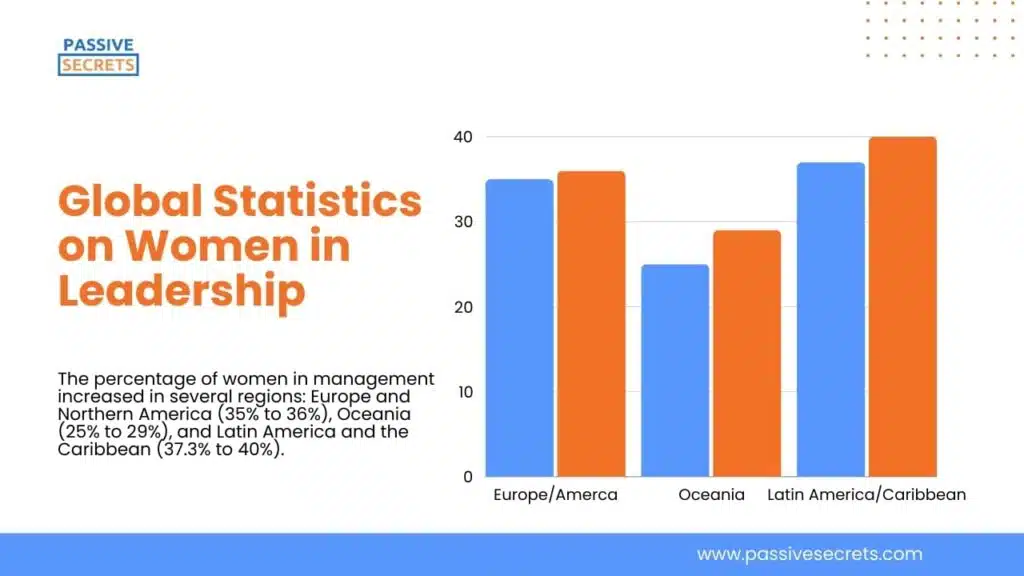
3. 90% of working women believe their own perseverance will accelerate their journey to leadership. (source)
4. 67% of women report learning the most important leadership lessons from other women. (source)
5. Also, 82% of women believe networking with female leaders will help them advance in their careers. (source)
6. Professional working women identify key skills needed for leadership development as leadership training (57%), confidence building (56%), decision-making (48%), networking (47%), and critical thinking (46%). (source)
They also emphasize the importance of company support for women’s development in their 20s (80%) and career advancement in their 30s (61%).
7. 86% of women are encouraged to pursue leadership roles when they see more women in leadership positions. (source)
8. Men and women have differing perceptions of female leadership, with 25% of women and only 11% of men believing women hold more than 51% of leadership positions. (source)
9. 47% of Americans believe traditional gender roles are important for success outside the home, with 53% of 18-34-year-olds (59% of men, 48% of women) sharing this view, compared to 40% of women and 50% of men aged 55 and over. (source)
10. The percentage of female CEOs in Fortune 500 companies has increased from 0% in 1995 to 10.6% in 2023, with 53 women now holding CEO positions. Katharine Graham paved the way as the first female CEO on the list in 1972. (source)
11. In 2023, 11% of FTSE 100 companies had a female CEO, compared to 4% of FTSE 250 companies, with FTSE 100 companies having higher female representation among CEOs and executive directors. (source)
12. Women hold 31% of leadership roles (up from 29% in 2022) and 32% of middle management roles. (source)
13. Companies with robust DEI programs have an average of 35% women leaders, compared to 25% in companies with weak or no DEI initiatives. (source)
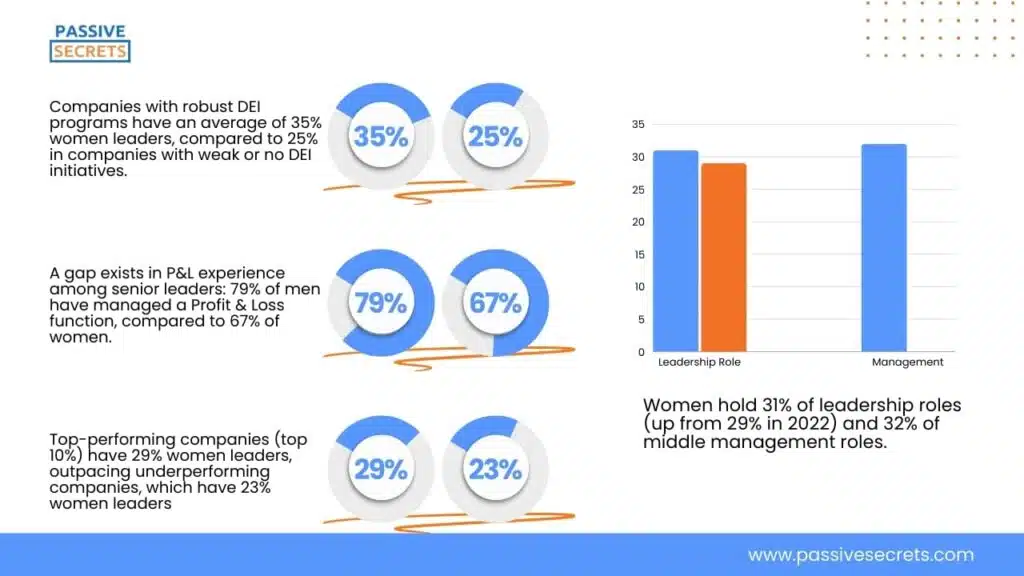
14. A gap exists in P&L experience among senior leaders: 79% of men have managed a Profit & Loss function, compared to 67% of women. (source)
15. Top-performing companies (top 10%) have 29% women leaders, outpacing underperforming companies, which have 23% women leaders. (source)
Women in Corporate Leadership
16. As of 2023, women hold 10.4% of leadership positions at Fortune 500 companies, with a record 52 female CEOs leading businesses on the list. (source)
17. As of 2022, women made up 58.4% of the US workforce but only 35% of senior leadership. (source)
18. Companies with female executives are 30% more likely to outperform others. (source)
19. Women hold less than a third (29%) of revenue-generating management roles, a slight increase from 27.6% in 2022 and 27% in 2021. (source)
20. Women occupy 42% of board seats in large UK companies, but only 10 are CEOs of FTSE 100 firms. (source)
21. In 2023, HSBC reported the following female representation: 47% on the holdings board, 34% in senior leadership and executive committee direct reports, and 21% on the group executive committee. (source)
22. Women comprise 42% of the Australian workforce, but only 25% of executives and 10% of CEOs in large for-profit companies. (source)
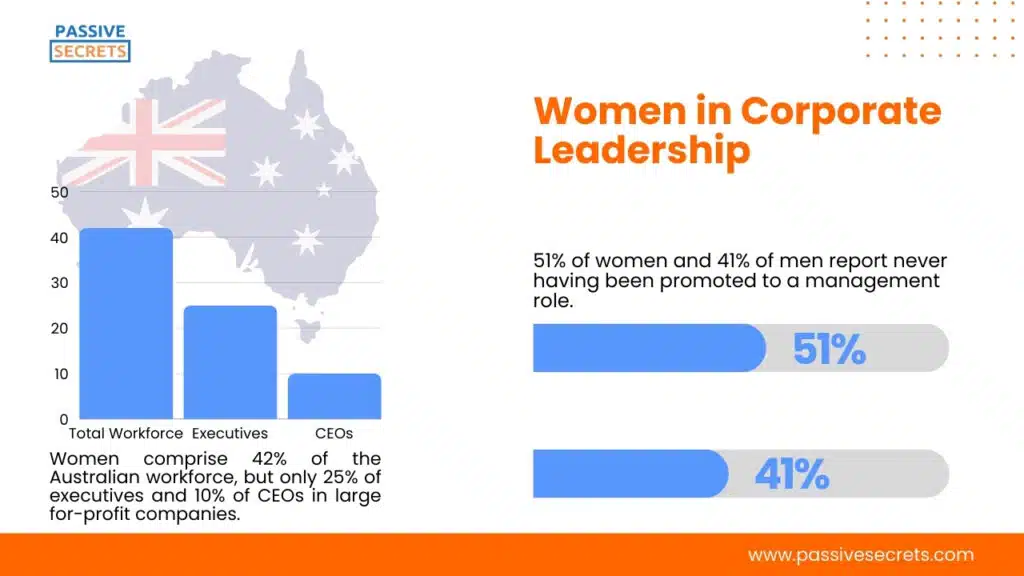
23. 51% of women and 41% of men report never having been promoted to a management role. (source)
Women in Political Leadership
24. As of October 1, 2024, 30 women hold the top spots as Heads of State and/or Government in 29 countries. Unfortunately, at this pace, it’ll take a staggering 130 years to achieve gender equality in these powerful positions. (source)
25. Sub-Saharan Africa still has a long way to go in closing its gender gap in politics, with only 18% of the gap closed. The region remains one of the toughest for women to rise to leadership positions in government. (source)
Currently, women make up just 22.5% of parliamentarians in the continent, which is lower than in Europe, Latin America, and Asia.
26. However, Rwanda stands out as a positive example, with women holding an impressive 63.8% of parliamentary seats, the highest rate globally. (source)
Senegal and South Africa also have significant female representation in parliament, with 43% and 42% respectively.
27. Unfortunately, many other African countries lag behind, with Swaziland having one of the lowest rates, where women hold only 6.2% of parliamentary seats. (source)
28. 67% of US adults believe a woman can be as qualified as a man to lead the country, with 41% of men and 38% of women saying it’s “very likely.” (source)
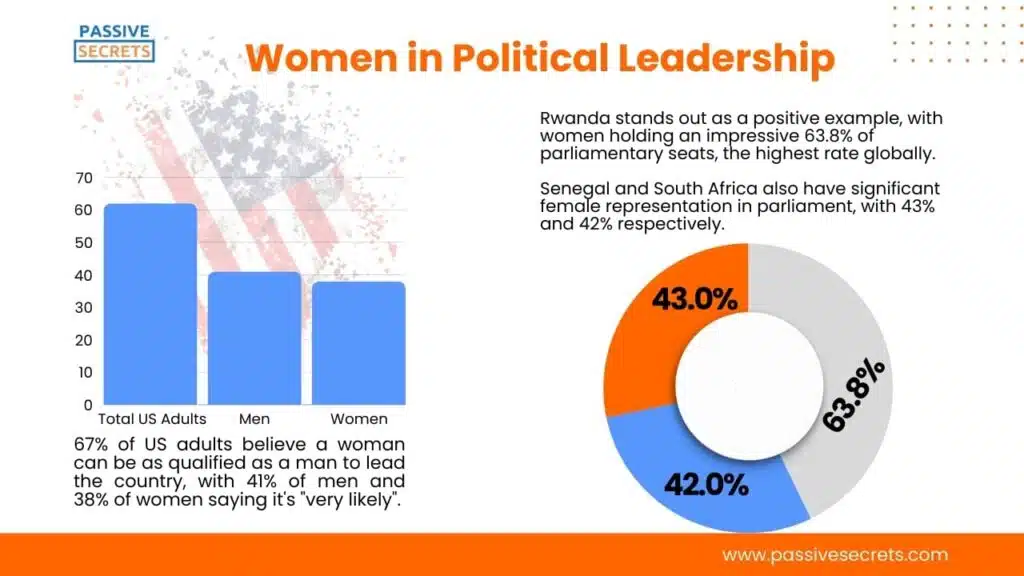
29. Since 1960, only 62 countries have had a female head of state or government, with just 11 countries currently led by women as of 2024. (source)
30. The percentage of women in parliaments has more than doubled, increasing from 11% to 26%, and the number of female heads of state has risen from 4 to 17. (source)
31. Almost 60% of countries, 113 to be exact, have never had a female head of state as of 2024. This highlights the significant underrepresentation of women in leadership positions worldwide. Currently, only 26 countries are led by a woman. (source)
Sector-Specific Women In Leadership Statistics
32. Women’s representation in STEM roles is highest in healthcare (41.1%), followed by consumer staples, real estate, and financials, while energy has the lowest representation, which decreased from 20.8% in 2021-2022 to 20.0% in 2023. (source)
33. Women hold just 25% of senior leadership positions in the healthcare sector. (source)
34. A recent survey found that organizations retain women in financial leadership roles mainly through flexible working options (71%), open and honest culture with anti-harassment policies (65%), and promoting opportunities and support networks (47%). (source)
35. Women hold 46% of entry-level positions, but this number drops to 25% at the C-suite level and further to 12% in STEM industry C-suite roles. (source)
36. In Europe’s financial services industry, women held 22.5% of senior leadership roles in 2022, expected to rise to 22.9% by 2031. However, the share of women among next-generation employees is forecasted to decrease from 27.9% in 2022 to 25.6% by 2031. (source)
37. In the UK’s top 80 energy companies, women hold 16% of executive board positions, and only six companies have female CEOs. (source)
38. In the FTSE 100, women hold 25% of finance director roles and 27% of chief information officer roles. Women comprise 30% of executive committees, and the number of FTSE 350 companies with all-male executive committees has decreased from 54 in 2017 to 9. (source)
39. A 2024 UK survey found that 53.5% of marketing directors/CMOs were women, with the highest proportion (55.5%) in B2B companies. (source)
40. Women hold 71% of Human Resource Director positions in the FTSE 100. Women hold 27% of Chief Information Officer roles and 25% of Finance Director positions. (source)
41. In the FTSE 350, women hold 42.1% of board seats, an all-time high. Additionally, 67% of FTSE 350 companies have 40% or more female board representation. (source)
Barriers/Challenges for Women In Leadership
42. In 2024, for every 100 men promoted to manager, 89 White women received promotions. (source)
43. Women of color only occupy 7% of C-suite positions. (source)
44. It would take 48 years for the representation of White women and women of color in senior leadership to match their share of the US population. (source)
45. In a recent survey, 64% of professional working women aspire to senior leadership roles, and over half (56%) aspire to serve on a board. (source)
However, more than half report being cautious in pursuing leadership roles due to their gender, and 60% struggle to envision themselves as leaders.
46. 76% of women wish they had learned more about leadership and had more leadership opportunities during their formative years. (source)
47. 67% of women say they need more support to build confidence to feel like leaders. (source)
This lack of confidence affects various activities, including:
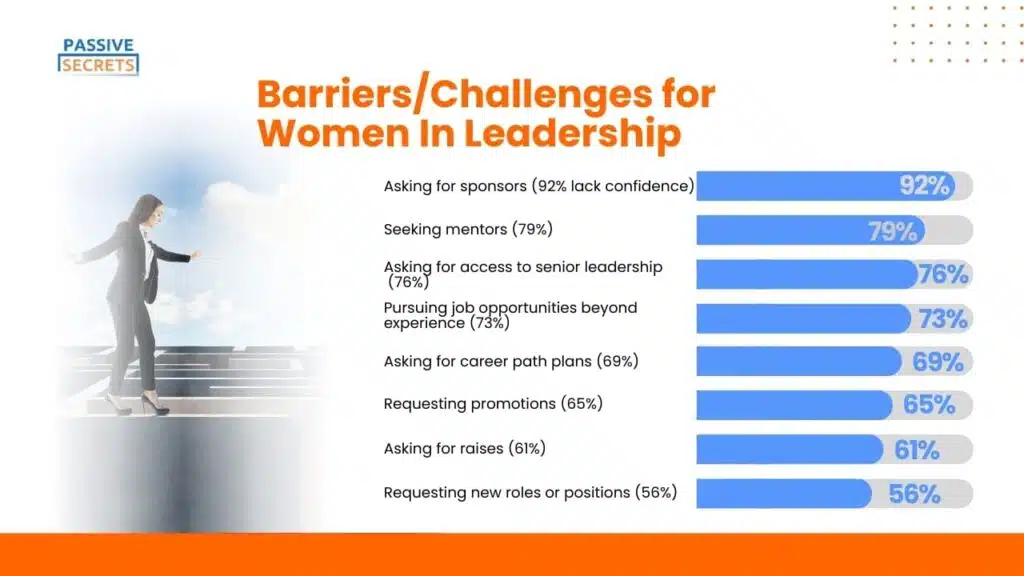
48. 33% of Americans (including 42% of married women) believe balancing work and family responsibilities is the biggest obstacle for women in leadership. (source)
49. The biggest drop-off in women’s representation occurs at the transition from key management positions to CEO, with a 59% decline. (source)
50. Women leaders are less likely to have had formal mentors than men: 24% vs 30%. This gap widens at senior levels, where 27% of women and 38% of men have had formal mentors. (source)
51. Women leaders are less likely than men to receive leadership development opportunities: 12% less likely to receive leadership skills training and 15% less likely to undergo leadership assessments. (source)
FAQs

Other Related Statistics You Should Know:
- Billionaire Statistics: Surprising Insights About The World’s Wealthiest
- 89 Business Loan Statistics Every Entrepreneur Should Know
- 70+ AI in Education Statistics That Prove the Future Is Already Here
- Soft Skills Statistics: Key Data on Demand, Training, and Impact
- 95+ Fascinating Gift Industry Statistics to Surprise and Delight
- Top Business Coaching Statistics & Trends Every Leader Should Know
- How Much Are People Saving? Key Personal Savings Statistics Explained
- 40+ Useful Procrastination Statistics To Help You
- 90 Amazing Millionaire Statistics & Facts You Dare Not Miss
- 50+ Latest Life Coaching Statistics And Huge Trends
- 30+ Useful Real Estate Photography Statistics and Trends You Need to Know
- Data-Driven Decision-Making Statistics: Trends, Benefits & Challenges
- 54 Incredible Goal-Setting Statistics To Help You
- 45+ Interesting Communication Skills Statistics & Huge Trends
- Body Language Statistics & Fun Facts To Boost Your Communication Skills
- 35 Interesting Public Speaking Fear Statistics & Fun Facts
- 25+ Most Interesting Emotional Intelligence Statistics & Fun Facts

